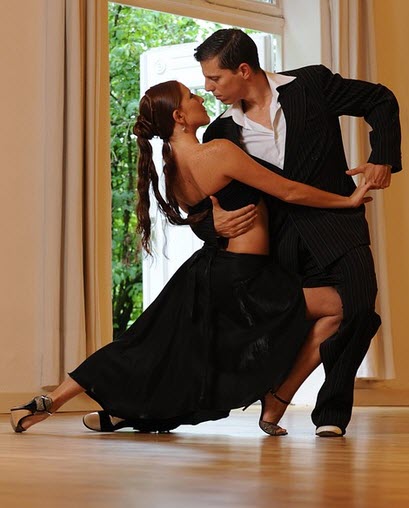Argentine tango is a social dance and an accompanying musical genre. It developed in South America in the late 1800s, with the cities Buenos Aires in Argentina and Montevideo in Uruguay as its two main hotspots.
A typical orchestra for Argentine tango music will include several melodic instruments. The bandoneon, a type of concertina, has been an essential instrument in Argentine tango ensembles from the 1910s and onwards.
When it comes to the lyrics, Argentine tango songs often revolve around lost love, sadness and/or nostalgia.
Contents
Examples of characteristics of Argentine tango dance
Basico

The basic step is called basico.
Improvisation
Improvisation is an important element of Argentine tango dancing.
The embrace
The embrace in Argentine tango can be anywhere on a spectrum from very closed to very open. When it is very open, they connect at arms length. When it is very closed, the partners connect chest-to-chest. (This distinguishes it from ballroom tango, where the partners connect in the upper thigh and hip area during a closed embrace.)
The feet
Generally speaking, both partners keep their feet close to the floor as the walk. It is common for ankles and knees to brush as one leg passes the other.
Leading and following
- The follower will usually be led to alternate feet.
- The follower will rarely have their weight on both feet simultaneously.
Line of dance
The couples dance counterclockwise around the outside of the dance floor.
When a couple enters the dance floor, they should not cut across the centre of the floor.
Stopping in the line of dance to peform a stationary figure is only accepted if the stop is brief and does not impede the other couples.
Argentine tango music
Compared to ballroom tango music, Argentine tango music is much more heterogeneous. Generally speaking, it has a strong tango-rythm based on the pattern dos por cuatro (2 x 4). The four main schools of Argentine tango music are Pugliese, Troilo, d’Arienzo and Di Sarli.
The first generation of tango music players in Argentina is referred to as the Gugardia Vieja (Old Guard). In the early 20th century Argentine, tango was largely seen as music for gangsters and other lowlifes, and was associated with brothels and other seedy businesses.
Early tango was played by orchestras who by necessity had to rely on instruments that were easy to carry around from one gig to the next, such as guitar, violin and flute, and – from 1910 or so – the bandoneón. When it comes to the bandoneón, Eduardo Arolas (1892-1924) was very important for its adoption by mainstream tango orchestras. Arolas is one of the early tango composers and orchestra leaders who helped define the Argentine tango music of this time. In addition to being a devoted fan of the bandoneón, he wasn’t scared to include other unconventional instruments, such as banjo, cello and even saxophone, when composing and performing his tango music.
Another notable character in the history of early Argentine tango music is Vicente Greco (1888-1924), a composer, conductor and bandoneon player who had a significant role in spreading this music from the poor suburbs into the city centres. The first tango he composed, “El morchito”, sold in 22,000 copies. Greco is seen as responsible for the standardisation of the tango sextet: two violins, two bandoneóns, one double bass and one piano.
This article was last updated on: September 19, 2023

